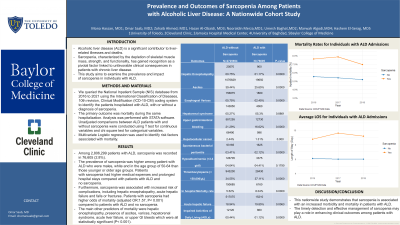Monday Poster Session
Category: Liver
P2958 - Prevalence and Outcomes of Sarcopenia Among Patients With Alcoholic Liver Disease: A Nationwide Cohort Study
Monday, October 28, 2024
10:30 AM - 4:00 PM ET
Location: Exhibit Hall E

Has Audio

Omar Saab, MD
Cleveland Clinic Foundation
Westlake, OH
Presenting Author(s)
Mona Hassan, MD1, Omar Saab, MD2, Zohaib Ahmed, MD3, Hasan Al-Obaidi, MD4, Nooraldin Merza, MD1, Umesh Baghat, MD5, Marwah Algodi, MD6, Hashem El-Serag, MD, MPH7
1University of Toledo College Medicine and Life Sciences, Toledo, OH; 2Cleveland Clinic Foundation, Westlake, OH; 3University of Toledo Medical Center, Toledo, OH; 4Jamaica Hospital Medical Center, Briarwood, NY; 5Cleveland Clinic Foundation, Cleveland, OH; 6University of Baghdad College of Medicine, Cleveland, OH; 7Baylor College of Medicine, Houston, TX
Introduction: Alcoholic liver disease (ALD) is a significant contributor to liver-related illnesses and deaths. Sarcopenia, characterized by the depletion of skeletal muscle mass, strength, and functionality, has gained recognition as a pivotal factor linked to unfavorable clinical consequences in patients with chronic liver disease. This study aims to examine the prevalence and impact of sarcopenia in individuals with ALD.
Methods: We queried the National Inpatient Sample (NIS) database from 2016 to 2021 using the International Classification of Diseases, 10th revision, Clinical Modification (ICD-10-CM) coding system to identify the patients hospitalized with ALD, with or without a diagnosis of sarcopenia. The primary outcome was mortality during the same hospitalization. Analysis was performed with STATA software. Unadjusted comparisons between ALD patients with and without sarcopenia were conducted using T test for continuous variables and chi square test for categorical variables. Multivariate Logistic regression was used to identify risk factors associated with mortality.
Results: Among 2,806,299 patients with ALD, sarcopenia was recorded in 76,605 (2.8%). The prevalence of sarcopenia was higher among patient with ALD who were males, white and in the age group of 50-64 than those younger or older age groups. Patients with sarcopenia had higher medical expenses and prolonged hospital stays compared with patients with ALD and no sarcopenia. Furthermore, sarcopenia was associated with increased risk of complications, including hepatic encephalopathy, acute hepatic failure and falls or fractures. Patients with sarcopenia had higher odds of mortality (adjusted OR:1.57, P< 0.001) compared to patients with ALD and no sarcopenia. The main other predictors of mortality were hepatic encephalopathy, presence of ascites, varices, hepatorenal syndrome, acute liver failure, or upper GI bleeds which were all statistically significant (P< 0.001).
Discussion: This nationwide study demonstrates that sarcopenia is associated with an increased morbidity and mortality in patients with ALD. The timely detection and effective management of sarcopenia may play a role in enhancing clinical outcomes among patients with ALD.
Note: The table for this abstract can be viewed in the ePoster Gallery section of the ACG 2024 ePoster Site or in The American Journal of Gastroenterology's abstract supplement issue, both of which will be available starting October 27, 2024.
Disclosures:
Mona Hassan, MD1, Omar Saab, MD2, Zohaib Ahmed, MD3, Hasan Al-Obaidi, MD4, Nooraldin Merza, MD1, Umesh Baghat, MD5, Marwah Algodi, MD6, Hashem El-Serag, MD, MPH7. P2958 - Prevalence and Outcomes of Sarcopenia Among Patients With Alcoholic Liver Disease: A Nationwide Cohort Study, ACG 2024 Annual Scientific Meeting Abstracts. Philadelphia, PA: American College of Gastroenterology.
1University of Toledo College Medicine and Life Sciences, Toledo, OH; 2Cleveland Clinic Foundation, Westlake, OH; 3University of Toledo Medical Center, Toledo, OH; 4Jamaica Hospital Medical Center, Briarwood, NY; 5Cleveland Clinic Foundation, Cleveland, OH; 6University of Baghdad College of Medicine, Cleveland, OH; 7Baylor College of Medicine, Houston, TX
Introduction: Alcoholic liver disease (ALD) is a significant contributor to liver-related illnesses and deaths. Sarcopenia, characterized by the depletion of skeletal muscle mass, strength, and functionality, has gained recognition as a pivotal factor linked to unfavorable clinical consequences in patients with chronic liver disease. This study aims to examine the prevalence and impact of sarcopenia in individuals with ALD.
Methods: We queried the National Inpatient Sample (NIS) database from 2016 to 2021 using the International Classification of Diseases, 10th revision, Clinical Modification (ICD-10-CM) coding system to identify the patients hospitalized with ALD, with or without a diagnosis of sarcopenia. The primary outcome was mortality during the same hospitalization. Analysis was performed with STATA software. Unadjusted comparisons between ALD patients with and without sarcopenia were conducted using T test for continuous variables and chi square test for categorical variables. Multivariate Logistic regression was used to identify risk factors associated with mortality.
Results: Among 2,806,299 patients with ALD, sarcopenia was recorded in 76,605 (2.8%). The prevalence of sarcopenia was higher among patient with ALD who were males, white and in the age group of 50-64 than those younger or older age groups. Patients with sarcopenia had higher medical expenses and prolonged hospital stays compared with patients with ALD and no sarcopenia. Furthermore, sarcopenia was associated with increased risk of complications, including hepatic encephalopathy, acute hepatic failure and falls or fractures. Patients with sarcopenia had higher odds of mortality (adjusted OR:1.57, P< 0.001) compared to patients with ALD and no sarcopenia. The main other predictors of mortality were hepatic encephalopathy, presence of ascites, varices, hepatorenal syndrome, acute liver failure, or upper GI bleeds which were all statistically significant (P< 0.001).
Discussion: This nationwide study demonstrates that sarcopenia is associated with an increased morbidity and mortality in patients with ALD. The timely detection and effective management of sarcopenia may play a role in enhancing clinical outcomes among patients with ALD.
Note: The table for this abstract can be viewed in the ePoster Gallery section of the ACG 2024 ePoster Site or in The American Journal of Gastroenterology's abstract supplement issue, both of which will be available starting October 27, 2024.
Disclosures:
Mona Hassan indicated no relevant financial relationships.
Omar Saab indicated no relevant financial relationships.
Zohaib Ahmed indicated no relevant financial relationships.
Hasan Al-Obaidi indicated no relevant financial relationships.
Nooraldin Merza indicated no relevant financial relationships.
Umesh Baghat indicated no relevant financial relationships.
Marwah Algodi indicated no relevant financial relationships.
Hashem El-Serag indicated no relevant financial relationships.
Mona Hassan, MD1, Omar Saab, MD2, Zohaib Ahmed, MD3, Hasan Al-Obaidi, MD4, Nooraldin Merza, MD1, Umesh Baghat, MD5, Marwah Algodi, MD6, Hashem El-Serag, MD, MPH7. P2958 - Prevalence and Outcomes of Sarcopenia Among Patients With Alcoholic Liver Disease: A Nationwide Cohort Study, ACG 2024 Annual Scientific Meeting Abstracts. Philadelphia, PA: American College of Gastroenterology.
